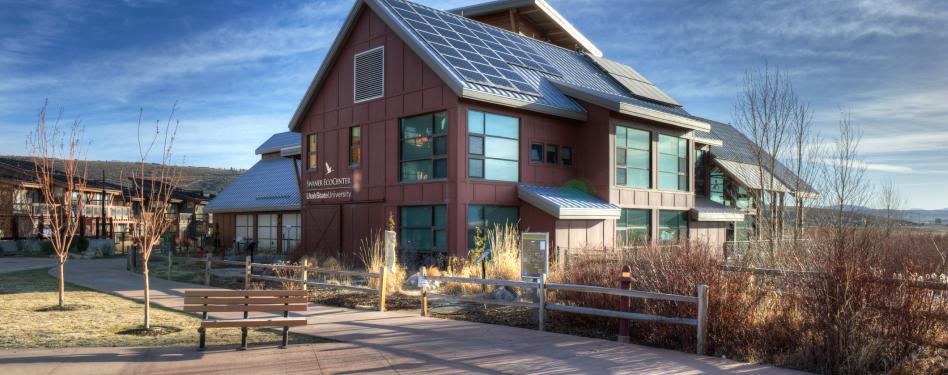
The SITES-certified Swaner Ecocenter in Park City, Utah. Photo credit: © Rob Holman.
In the beginning of May, USGBC Utah, along with ASLA Utah and Salt Lake City's Sustainable Infrastructure Committee and Public Lands Department, hosted USGBC's first event in Utah since 2018, drawing a full room of engaged attendees eager to explore how SITES can support responsible growth across the Mountain region. With Utah’s rapid market expansion and irreplaceable natural landscape, the event centered on strategies to promote responsible site development and ecosystem resilience through the SITES rating system.
Making the case for SITES
Danielle Pieranunzi, SITES director at GBCI/USGBC, started the day by orienting attendees to the SITES rating system and its core values: protecting and restoring ecosystem services by implementing nature-based solutions while enhancing community quality of life, conserving resources and fostering resilience and environmental stewardship. She reviewed the SITES certification pathways, credit categories and a range of other topics, from carbon and biodiversity to resilience and human health, and how the credits can contribute to functional, regenerative landscapes and healthy and meaningful outdoor spaces.
SITES can be applied to project types with or without buildings, including open space, streetscapes and plazas, or commercial, residential or educational/institutional areas and campuses. To date, over 400 projects are participating in the SITES program across 25 countries and 41 U.S. states, as well as the District of Columbia, covering 1.36 billion square feet of landscapes and outdoor spaces.
The SITES and LEED rating systems are complementary, so teams can use them independently or in tandem. To learn more about these synergies and how they may apply to a LEED project, download GBCI’s online LEED to SITES readiness tools for free. A tool reflecting synergies between SITES and the new LEED v5 rating system is currently in development.

Photo credit: Lauren Farkas.
Putting SITES into practice
A standout moment of the event came from Will Howard of Stack Rock Group, who shared a compelling case study from Hewlett-Packard’s (HP) 200-acre Boise, Idaho, campus. By rethinking landscape design and maintenance practices, the project has reduced site maintenance costs by 43%, with a 1.6-year payback on project costs, while also increasing biodiversity and drastically reducing carbon emissions and water use—saving the equivalent of 33 Olympic swimming pools of water per year.
The HP campus earned SITES Gold, making it the first SITES-certified project in Idaho and the first SITES v2 certified corporate campus globally.
City-level innovation in Salt Lake City and Austin
Nancy Monteith, senior landscape architect for the Public Lands Department for Salt Lake City, Utah, and Sarah Talkington, sustainability and resiliency engineer with parks and recreation for the city of Austin, Texas, showcased how municipal adoption of SITES can drive large-scale change. Both Salt Lake City and Austin have integrated SITES into their sustainable infrastructure policies and are using it to improve planning, budgeting and accountability across departments.
Talkington, with Austin, the first city to adopt SITES globally, emphasized how early workshops and cross-departmental collaboration helped overcome barriers. Today, Austin has 12 registered SITES projects and continues to lead with a strong green infrastructure policy and climate goals.
To build on the success of Austin’s local SITES implementation, attendees in Utah broke off into groups for workshop-style collaboration and brainstorming on the following topics:
- The business case for SITES
- Barriers to implementation
- Ways to overcome barriers by getting into the weeds to determine what tools can help you meet relevant criteria within each credit category
The day ended with a tour of the planned renovation of Pioneer Park. This was led by Jamie Fogle of Design Workshop, the firm leading the design and renovation, and Nancy Monteith. They shared how the park’s renovation is using the principles of SITES to create a space that enhances ecological diversity, improves air quality, boosts human health and invites community convenings in the heart of downtown.
Next steps
From attracting investments and reducing costs to boosting environmental health and climate resilience, the benefits are clear: Properly planned parks, landscapes and open spaces can serve as carbon sinks, improve water quality, reduce water consumption, mitigate urban heat island effects, deliver long-term savings and more.
As the demand for sustainable development accelerates, SITES offers a road map for cities, companies and communities to protect what makes places like Utah and Austin so special, while also planning for growth. USGBC is expanding its tools and training to support the education and adoption of SITES. Available resources, such as the "Designing for the Future" handout, and upcoming education and events, can be found on the SITES website.
